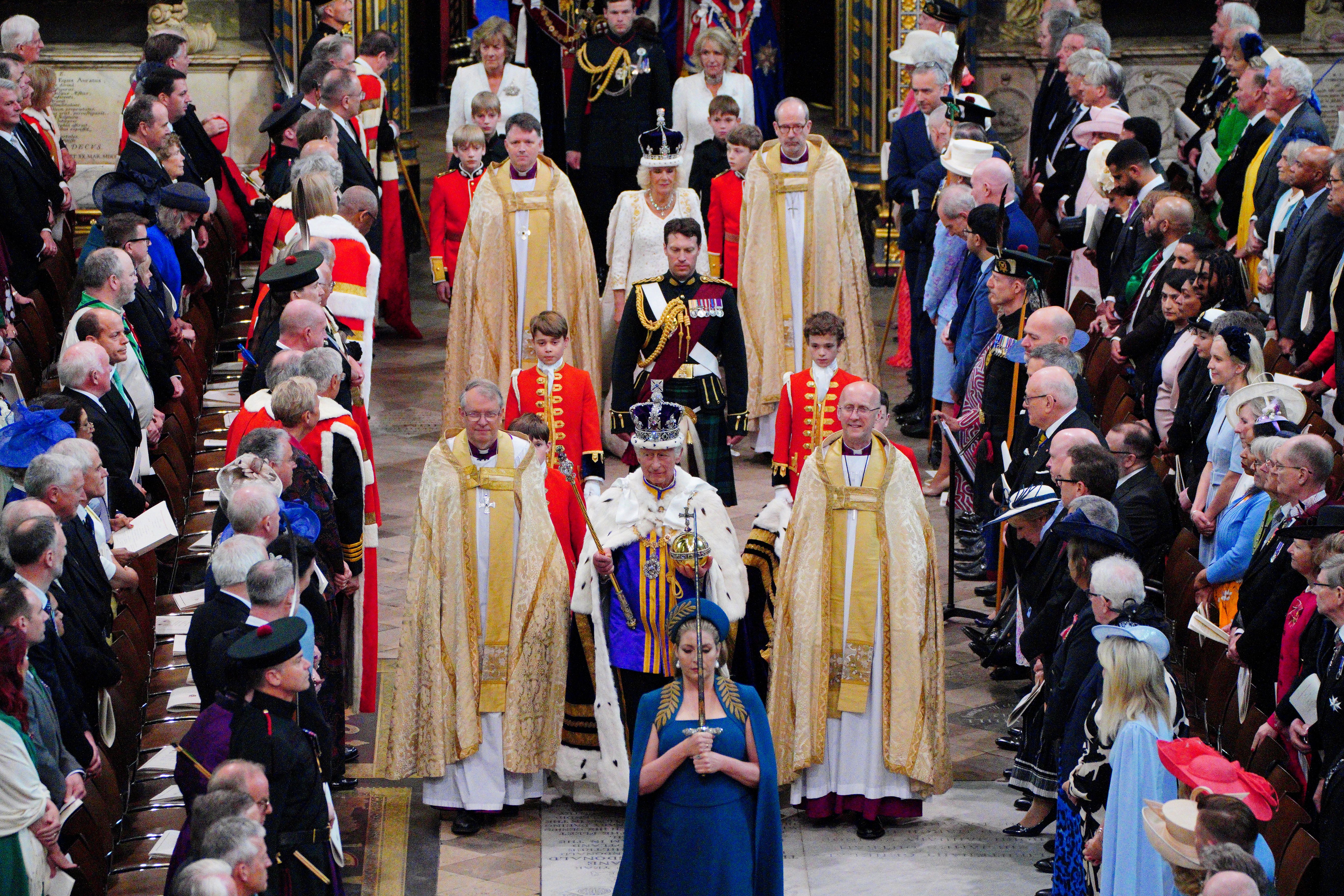How the battle of coronation commentary played out for BBC, ITV and Sky
Cameras, perched in the rafters of the nave, peered down on the service like the bird’s eye view of a football match, writes Nick Hilton


On a drizzly June day in 1953, Elizabeth, the young princess who had, the year before, become Queen, arrived on the world’s television screens. Her coronation was a landmark for small screen audiences – only the second world event to receive an international broadcast – and, apocryphally, precipitated a vast increase in the number of television sets in Britain. We became, almost overnight, a nation of square-eyed, goggle-box obsessives. And that was all thanks to Her late Majesty. Now, on a drizzly May day in 2023, it fell to her son, Charles III, to shake his tail feather in front of a world with a more entitled sense of access to splendour.
While Elizabeth II’s trip to Westminster Abbey was broadcast solely via the BBC (ITV, after all, didn’t come into existence until 1955), today’s ceremony aired across terrestrial channels (with only Channel 4 demurring and showing Johnny English Strikes Again instead) and via international broadcasters from CBS in the United States to Das Erste in Germany. Like the Queen’s funeral last year, the pageantry was unavoidable.
In the build-up, the BBC gave the commentary reins to Clare Balding, a seamless multi-register presenter as comfortable talking about ladies-in-waiting as synchronised swimmers (though the rain driving down on the Mall might have temporarily elided that difference). Julie Etchingham and Tom Bradby, who have been given extensive royal duties over the past year, led ITV’s team. The third channel also dispatched Charlene White to reunite with Ant and Dec (esteemed guests of the new king), who she last saw on the set of I’m a Celeb. This was about as close as either broadcaster came to a concession to youth. In the early morning shift on the BBC, Kirsty Young sat down with an incongruous range of Boomer celebrities, from Gyles Brandreth to Craig Revel Horwood, via Sanjeev Bhaskar and David Harewood.
Sky gave prime position to Kay Burley, who brought a wild-eyed intensity to match the sleep-deprived obsessives lining the road to the Abbey. Talking heads like Anthony Seldon and Alastair Bruce gave Sky’s coverage a less sombre, more journalistic tone, but on the more glamorous front, they roped in Joanna Lumley, wearing one of the more splendid hats in SW1, to give her jolly viewpoints. Of the broadcasters, perhaps the greatest feat of endurance was provided by GB News, which decamped to the Palace to cover proceedings through the night.
Once the coronation began in earnest, the centrally broadcast feed took over. This was roughly divided into three segments: the arrival of dignitaries, the procession of the King and Queen, and the ceremony itself. In the first of these, Huw Edwards was in his pomp (and the BBC in its element) pointing out heads of state, politicians and celebrities for the viewing public. Nick Cave, Katy Perry, Emma Thompson, Lionel Richie: the drab queues of officials were occasionally sprinkled with stardust.
The camera avoided more salacious shots of Prince Harry or his uncle, Andrew, in favour of returning, again and again, to Prince George (now second in line to the throne). As the lengthy ceremony drew on, the nine-year-old looked increasingly tired. As did poor Penny Mordaunt, whose valiant sword-carrying will have captivated audiences and inspired a few gym subscription renewals.
In the ceremony, the coverage became more reverent. Bespectacled Justin Welby, the Archbishop of Canterbury, lacks the gravitas of his predecessor (or Huw Edwards). He is not the emcee that the global broadcast networks would’ve chosen (on paper the gig has Rylan’s name written all over it), but with superstars like Bryn Terfel, Roderick Williams, the Byzantine Chant Ensemble and the gospel singers of the Ascension Choir contributing to proceedings, there was enough televisual charisma to go around.

For the first hour, Edwards rarely interjected, though explanatory subtitles at times distracted from the solemn mysteries of the service. Do the public really need a pop-up telling them that a song, where the words “Zadok the Priest!” are immediately belted out, is called “Zadok the Priest”? But for all the wattage provided by ancillary performers and a setlist of liturgical bangers, the eye was perpetually drawn to the new King and Queen. Charles, a figure of determined sobriety, his face gripped in a characteristic grimace; Camilla, channelling the best impersonation of her mother-in-law, but inexorably drawn to fussing with her hair.
A coronation is, at its heart, a religious ceremony; one of the few broadcast on British television (and possibly the only one to make it to Sky News). But it’s something the BBC actually do very well: from Carols at King’s to Songs of Praise, the provisions for the corporation’s vanishing Anglican audience are well directed. The necessity of leaving the floor of Westminster Abbey open for the service ensured that the King, Archbishop and other protagonists were shot almost exclusively from above. Cameras, perched in the rafters of the nave, peered down on the service like the bird’s eye view of a football match. For all the new inclusivity of the ceremony (commentators did not draw attention to “people of all faiths”, though tabloid columnists doubtless will) the sight of a 74-year-old man kissing a Bible felt strikingly traditional.

Watch Apple TV+ free for 7 day
New subscribers only. £9.99/mo. after free trial. Plan auto-renews until cancelled.
ADVERTISEMENT. If you sign up to this service we will earn commission. This revenue helps to fund journalism across The Independent.

Watch Apple TV+ free for 7 day
New subscribers only. £9.99/mo. after free trial. Plan auto-renews until cancelled.
ADVERTISEMENT. If you sign up to this service we will earn commission. This revenue helps to fund journalism across The Independent.

Like all coverage of events involving the Commonwealth, there was a natural tension between the celebration of countries who recognise Charles as king and recognition that the British Empire is no longer a mainstream subject of veneration. For once, however, these anxieties were largely set aside. For all the debates that have racked the National Trust, the British Museum, the Tate, universities and almost all cultural institutions in the past few years, the coronation was largely devoid of introspection. Perhaps the BBC, ITV and Sky felt unleashed from obligations to solicit a younger demographic. This was broadcasting that embraced its natural conservatism.
All the channels covering the day’s events referenced the years – almost 70 of them – that Charles has had to prepare for this day. It’s not just Charles who has had decades to dream of proceedings. The Church of England, the custodians of Westminster Abbey, and, crucially, the broadcasters have also had a lifetime to ready themselves. The striking image of the King, glittery sword in hand, wearing a golden kimono as the enormous crown was placed upon his head, might not carry the same historical weight as those images from 1953, but the broadcast tableau will live long in the public memory. For all the premature obituaries for monarchy, this marathon broadcast felt like a reaffirmation, not a repudiation, of British tradition.
Join our commenting forum
Join thought-provoking conversations, follow other Independent readers and see their replies
Comments


Bookmark popover
Removed from bookmarks